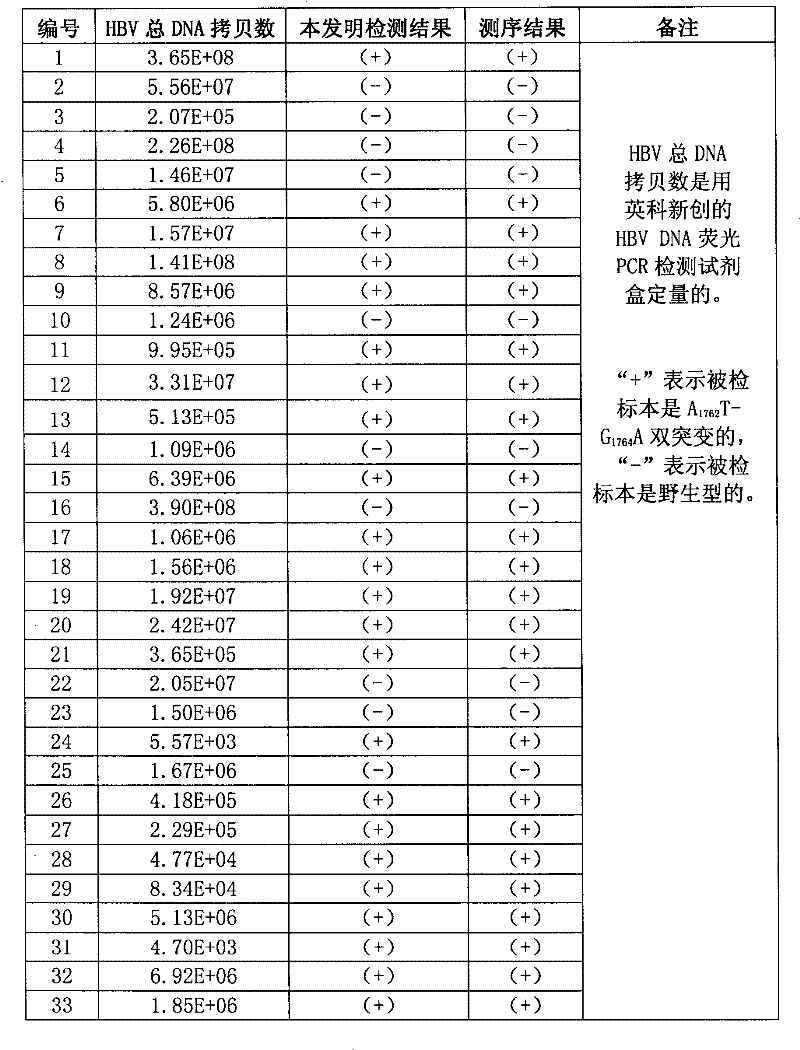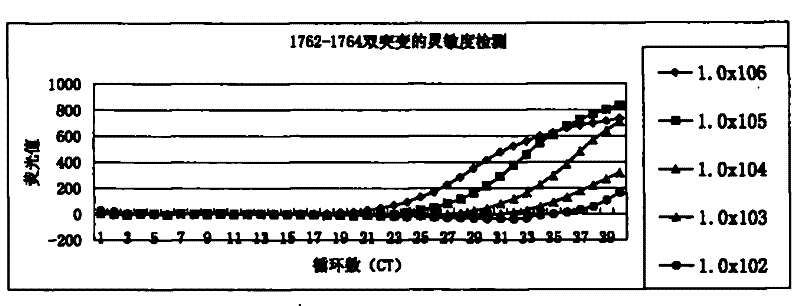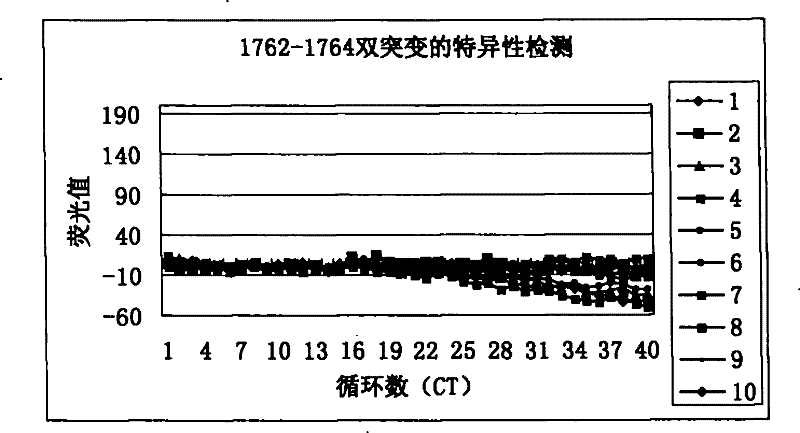Method for detecting A1762T-G11764A double-mutation of hepatitis B virus DNA and kit
A technology of DNA A1762T-G1764A and A1762T-G1764A, which is applied in the field of detection of hepatitis B virus DNA A1762T-G1764A double mutation, can solve the problems of troublesome sequencing methods, linear probe specificity is not as good as molecular beacons, etc., and achieve reliable detection results , The detection result is beautiful and stable, and the effect of reducing the detection cost
- Summary
- Abstract
- Description
- Claims
- Application Information
AI Technical Summary
Problems solved by technology
Method used
Image
Examples
Embodiment 1
[0078] Embodiment 1: Extraction of hepatitis B virus DNA in clinical blood samples
[0079] Take 50 μl of serum from clinical blood samples into a high-pressure 1.5ml centrifuge tube, add 25 μl of extraction solution A (40% PEG-8000), shake and mix for 5 seconds, centrifuge at 12,500 g for 5 minutes; discard the supernatant, add 25 μl of extraction Solution B (0.25M NaOH), shake for 15s to dissolve the precipitate as much as possible, lyse at 96°C for 10min; add 25μl of extract solution C (0.4M Tris-HCl buffer, pH6.4), mix well, 96°C for 10min; centrifuge at 12,500g After 15 minutes, 5 μl of the supernatant was taken for PCR amplification.
Embodiment 2
[0080] Embodiment 2: PCR amplification of target nucleic acid
[0081] Add a single serving of PCR reaction mixture into a PCR reaction tube, then add 0.2 μl of enzyme mixture, and finally add 5 μl of template (template to be tested or negative and positive control), mix thoroughly and centrifuge slightly (about 5 second). Then put the reaction tube into a PCR machine (a PCR machine that can detect FAM), and amplify according to the following conditions: 50°C for 120 seconds (1 cycle) → 95°C for 180 seconds (1 cycle) → 95°C for 10 seconds, 58°C °C for 30 seconds, 35 °C for 30 seconds (40 cycles). Among them, 58°C is the annealing temperature, and 35°C is the temperature for detecting fluorescence.
[0082] The PCR amplification system used included: 2.5 μl 10×PCR buffer (850 mM KCl, 400 mM Tris-Cl, pH8.9, 50% v / v glycerol), 0.2 μl enzyme mixture, 0.2 μl dUTPs (containing dATP, dUTP , dGTP, dCTP each 25mM), two forward and reverse primers (SEQ ID NO: 1 and SEQ ID NO: 2, 100 ...
Embodiment 3
[0083] Example 3: Sensitivity and specificity detection of hepatitis B virus DNA A1762T-G1764A double mutation
[0084] The plasmid (1.0×10 6 copies / ml-1.0×10 2 copy / ml) is template, use reagent of the present invention to hepatitis B virus DNA A 1762 T-G 1764 The sensitivity of the A double mutation was detected, and the detection results can be found in the appendix figure 1 . from figure 1 As can be seen from the results, the method and kit of the present invention can at least detect that the template concentration is only 1.0×10 2 copy / ml of A 1762 T-G 1764 A double mutant hepatitis B virus DNA. In other words, the sensitivity of the present invention can fully meet the clinical needs.
[0085] With 10 plasmids (about 1.0×10 6 copies / ml) is template, use reagent of the present invention to hepatitis B virus DNAA 1762 T-G 1764 The specificity of the A double mutation was tested, and the test results can be found in the appendix figure 2 . from figure 2 I...
PUM
 Login to View More
Login to View More Abstract
Description
Claims
Application Information
 Login to View More
Login to View More - R&D
- Intellectual Property
- Life Sciences
- Materials
- Tech Scout
- Unparalleled Data Quality
- Higher Quality Content
- 60% Fewer Hallucinations
Browse by: Latest US Patents, China's latest patents, Technical Efficacy Thesaurus, Application Domain, Technology Topic, Popular Technical Reports.
© 2025 PatSnap. All rights reserved.Legal|Privacy policy|Modern Slavery Act Transparency Statement|Sitemap|About US| Contact US: help@patsnap.com



